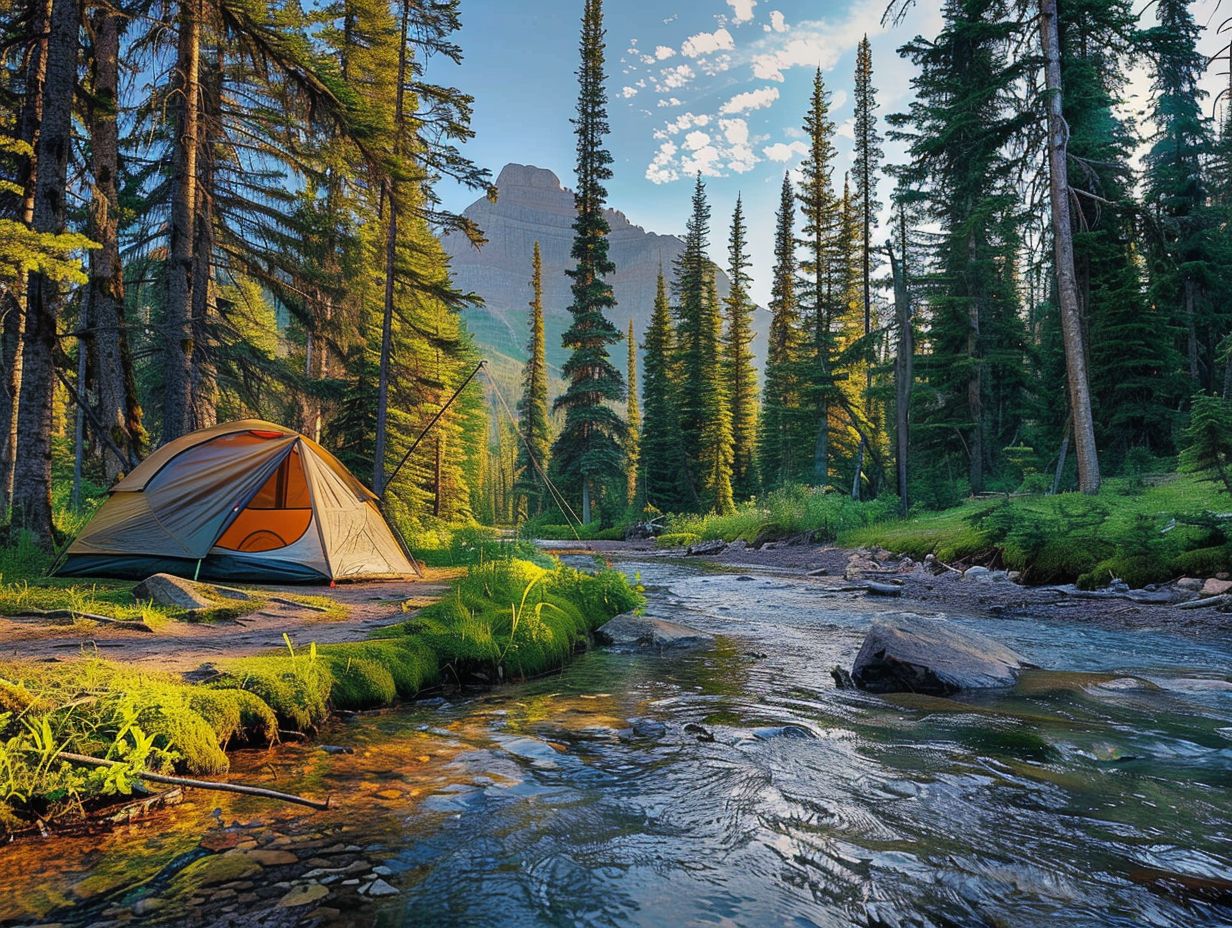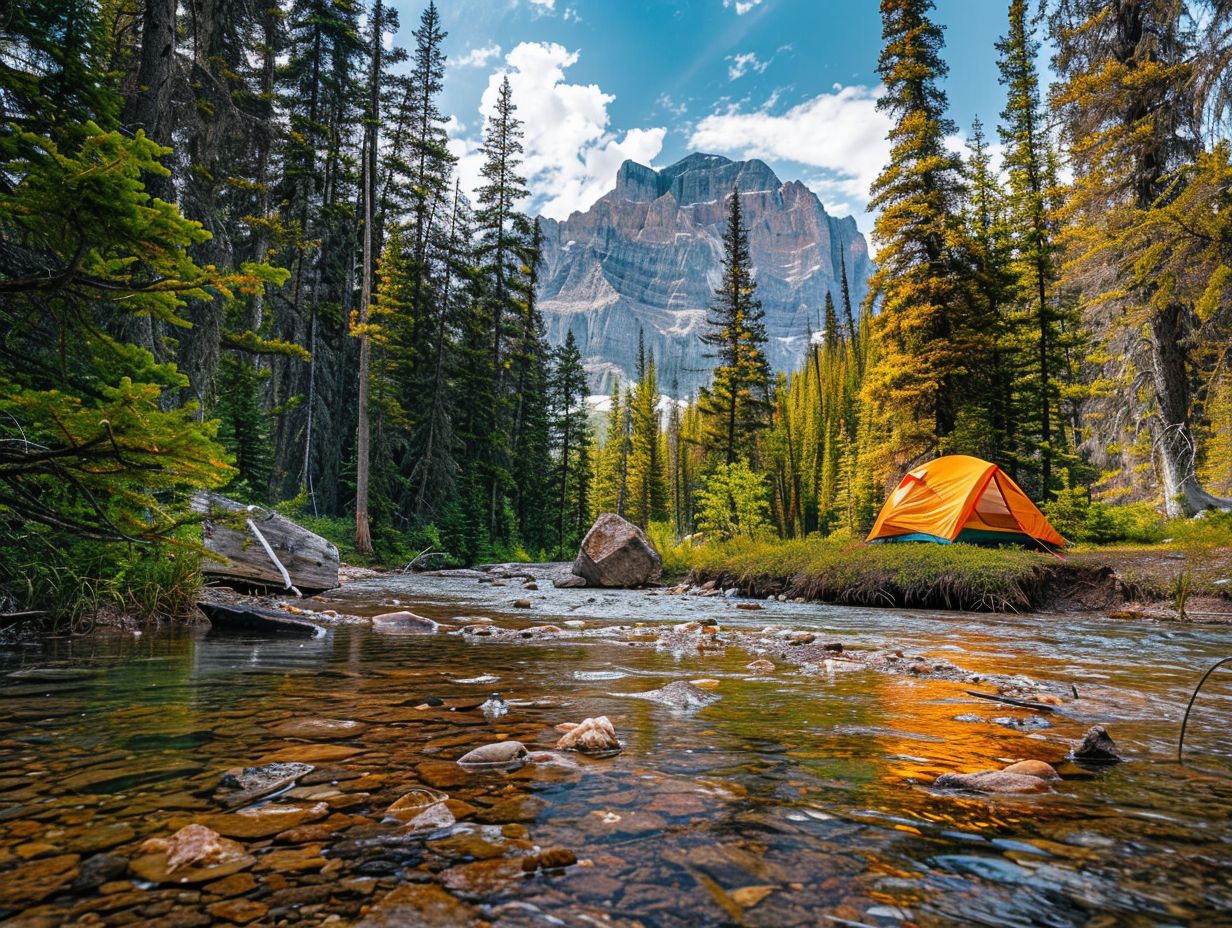Are you a nature lover who enjoys spending time in the great outdoors? If so, it’s essential to consider the impact your camping trip may have on the environment.
In this article, we will explore the importance of camping with minimal impact and provide you with tips on how to prepare for an environmentally friendly camping trip.
From essential items to leave no trace principles, setting up camp, disposing of waste properly, minimising your impact while hiking, and leaving the campsite better than you found it, we’ve got you covered.
Let’s dive in and learn how to enjoy nature responsibly.
Key Takeaways:

- Minimise your camp’s impact on the environment by following the Leave No Trace principles and properly disposing of waste.
- Prepare for an environmentally friendly camping trip by bringing essential items, planning your route, and avoiding campfires when possible.
- Leave the campsite better than you found it by practicing good waste management, staying on designated trails, and leaving a positive impact on the local community.
Why Is It Important To Camp With Minimal Impact On The Environment?
The practice of camping with minimal impact on the environment is crucial for sustainable camping endeavors.
This approach plays a significant role in preserving natural habitats, reducing ecological footprints, and ensuring that the splendor of nature remains available for enjoyment by future generations.
Incorporating sustainable methods, such as adhering to Leave No Trace principles, enables campers to minimise their effects on delicate ecosystems.
This involves proper waste disposal, the use of biodegradable products, and showing respect for wildlife habitats. By treating the land with care, campers can safeguard biodiversity and foster the thriving of plant and animal species within their natural surroundings.
For instance, opting for reusable camping equipment, as opposed to single-use items, helps to cut down on waste and pollution, thus promoting a healthier ecosystem conducive to the harmonious coexistence of all living beings.
How To Prepare For An Environmentally Friendly Camping Trip?
Planning for an environmentally conscious camping trip entails choosing eco-friendly equipment, strategising your route to reduce environmental effects, and implementing camping methods that conserve water and energy, especially in varied ecosystems such as those present in Australia.
What Are The Essential Items To Bring?
In anticipation of an environmentally sustainable camping excursion, it is imperative to select eco-friendly equipment crafted from sustainable materials noted for their durability and longevity.
Opting for items such as a solar-powered charger serves the purpose of keeping electronic devices operational without dependence on conventional energy sources, thereby significantly diminishing one’s carbon footprint.
Equally essential is the inclusion of a reusable water filter or purifier, which serves to curtail the generation of single-use plastic waste by enabling individuals to safely consume water from natural sources. The choice of biodegradable soap and detergents is also instrumental in preserving the cleanliness of the campsite without inflicting harm on the environment.
How To Plan Your Route?
To strategise for an eco-conscious camping trip, it is essential to prioritise pathways and camping sites that have minimal impact on the environment and adhere to relevant local regulations.
When determining your route, it is advisable to choose established trails to reduce disruption to plant life and fauna. Ahead of commencing the trip, it is crucial to review any restrictions or directives established by local governing bodies.
It is imperative to avoid sensitive regions such as bodies of water, meadows, and fragile ecosystems. Demonstrating consideration for wildlife habitats involves observing from a distance, refraining from direct interaction, and abstaining from leaving behind food remnants that might disturb their natural behaviour.
What Are The Leave No Trace Principles?
The Leave No Trace principles constitute a set of guidelines crafted to assist campers in minimising their environmental impact by advocating for practices that conserve nature and its biodiversity. These principles play a crucial role in ensuring the preservation of the natural beauty of our surroundings remains intact.
The principle of ‘Plan Ahead and Prepare‘ underscores the significance of conducting thorough research on the camping area, taking into account factors such as weather conditions, local regulations, and wildlife habitats.
‘Travel and Camp on Durable Surfaces‘ serves as a reminder for campers to adhere to designated trails and campsite pads to prevent erosion and habitat destruction.
‘Dispose of Waste Properly‘ promotes the practice of packing out all rubbish, disposing of human waste in designated facilities, or burying it in a cathole.
What Are The Best Practices For Setting Up Camp?
Establishing a campsite in adherence to best practices entails:
- Selecting a suitable location that mitigates impact on natural habitats
- Meticulously arranging your tent to prevent environmental damage
- Exploring alternative options to conventional campfires
How To Choose A Campsite?

The process of choosing a campsite involves the deliberate selection of a location that minimises environmental impact and adheres to local regulations in order to preserve natural habitats and wildlife. It is essential to bear in mind certain key considerations when deciding on a campsite.
Fragile areas, such as wetlands, delicate vegetation, and locations susceptible to erosion, must be avoided to safeguard the ecological equilibrium of the environment. It is imperative to strictly follow the regulations and guidelines established by local governing bodies to safeguard these sensitive ecosystems.
Furthermore, the impact on local wildlife and vegetation should be taken into account when choosing a campsite. Opt for a location that minimises disturbances to their natural habitat and food sources.
By conscientiously considering these factors, individuals can engage in camping activities responsibly, thus contributing to the conservation and preservation of the natural environment’s beauty.
How To Set Up A Tent Without Causing Damage?
To establish a tent without causing harm, it is imperative to carefully select a level and sturdy surface to prevent soil erosion and safeguard vegetation.
Ahead of pitching the tent, it is essential to assess the ground conditions. Identifying areas with minimal vegetation and clearing any debris that may puncture the tent groundsheet are key considerations.
Additionally, using a footprint or groundsheet beneath the tent can provide added protection to the ground whilst reducing environmental impact. When securing the tent pegs, it is advisable to do so with care to prevent any harm to the soil and underlying roots.
Adhering to these considerate camping practices allows individuals to enjoy the outdoors while preserving the integrity of the natural environment.
What Are The Alternatives To Campfires?
Substitutes for traditional campfires, such as the use of portable stoves or solar-powered cookers, serve to reduce environmental impact and mitigate the risk of wildfires.
These alternative methods not only offer a safer way of cooking and staying warm in outdoor settings, but they also promote sustainability by decreasing carbon emissions and preserving natural resources.
Portable stoves, which run on clean-burning fuels like propane or alcohol, are distinguished by their efficiency and ease of use.
In contrast, solar-powered cookers utilise renewable solar energy, making them a cost-effective and eco-friendly option for preparing meals. Embracing these environmentally friendly alternatives allows individuals to enjoy the outdoors while contributing to the conservation of our planet.
How To Dispose Of Waste Properly While Camping?
Appropriate waste disposal during camping requires adherence to principles such as:
- Ensuring the removal of all rubbish
- Recycling whenever possible
- Considering composting for biodegradable materials to lessen environmental impact
How To Pack Out Your Trash?
Proper waste management practices dictate that all refuse produced during a camping trip must be gathered and transported for appropriate disposal, adhering to the principles of Leave No Trace.
To reduce the production of waste, individuals may consider using minimally packaged or unpackaged items, using reusable containers or bags for food storage, and choosing products with fewer single-use plastic components. The use of strong containers not only helps to secure waste during transport but also reduces the chances of leaks or spills.
Before leaving the campsite, it is crucial to carefully search for any leftover waste, paying special attention to small items such as bottle caps or food wrappers. Remembering to leave no trace ensures the preservation of the pristine natural beauty of the wilderness for future visitors.
What Are The Guidelines For Human Waste Disposal?
The guidelines for the disposal of human waste in the wilderness emphasise the importance of utilising designated facilities or employing proper techniques such as burying waste to prevent contamination of the environment and water sources.
One commonly recommended method for disposing of waste while outdoors is the use of catholes. This technique involves digging a hole approximately 6-8 inches deep and maintaining a distance of at least 200 feet from any water sources. After use, the cathole should be covered with soil to facilitate the proper decomposition of waste.
Alternatively, individuals may opt to utilise portable toilets that are specifically designed for outdoor activities, ensuring that waste is contained and can be disposed of appropriately.
It is essential to also pack out any hygiene products and rubbish to preserve the area’s cleanliness for future visitors, in adherence to the Leave No Trace principles.
How To Properly Dispose Of Greywater?
The proper disposal of greywater requires the use of biodegradable soap and the dispersal of water at a minimum distance of 200 feet from water sources to prevent any form of contamination.
Incorporating greywater-friendly cleaning products and implementing techniques such as mulching basins, drip irrigation, or underground infiltration systems can further contribute to the responsible disposal of greywater. These methods not only alleviate the burden on sewage systems but also enhance soil quality by introducing nutrients that support improved plant growth.
It is imperative to prevent the accumulation of greywater or the creation of standing water, as this could attract pests and pose potential health hazards.
What Are The Best Ways To Minimise Your Impact While Hiking?

Reducing one’s environmental footprint during hiking activities requires adherence to designated paths, showing respect for wildlife, and avoiding causing harm to vegetation. These practices are essential for conserving the natural environment and enhancing biodiversity.
How To Stay On Designated Trails?
Adherence to designated paths is essential in reducing environmental impact, as it helps to mitigate soil erosion, protect vegetation, and comply with regulatory standards.
Moreover, following the designated paths ensures the conservation of wildlife habitats and reduces the spread of invasive species.
When exploring natural landscapes, it is vital to check signs, path markers, or guideposts to easily identify the designated routes. Adhering to these specified paths not only conserves the ecosystem but also enhances safety measures by avoiding potentially dangerous areas.
By sticking to designated paths, a commitment to environmental responsibility and awareness is promoted, encouraging a sustainable ethos in outdoor recreational activities.
What Are The Guidelines For Wildlife Encounters?
When encountering wildlife, it is imperative to adhere to ethical practices by maintaining a safe distance, refraining from feeding animals, and respecting their natural behaviours. These guidelines are essential for the protection of both the animals and the environment.
Observing wildlife from a distance enables them to engage in their regular activities without any external disruptions, ensuring that their behaviours remain unaffected and natural.
The act of refraining from feeding animals is of utmost importance as it can disrupt their natural diet and potentially lead to a reliance on human food sources, thereby impacting their overall health and long-term survival.
By conscientiously following these principles, we contribute to the preservation of the intricate balance of ecosystems and foster harmonious coexistence with the wildlife in our surroundings.
How To Avoid Damaging Vegetation?
Preserving vegetation whilst engaging in hiking activities entails adhering to designated trails, refraining from trampling plants, and exhibiting awareness in sensitive areas to mitigate soil erosion. When traversing nature trails, it is imperative to resist the temptation of creating shortcuts through dense vegetation in order to protect fragile plant life.
By adhering to established pathways, individuals can contribute to the preservation of the natural ecosystem and diminish the likelihood of disrupting habitats.
Acquiring knowledge on how to recognise vulnerable ecosystems, such as wetlands or alpine regions, give the power tos individuals to modify their course and behaviours appropriately to safeguard these significant plant communities.
Additionally, to further mitigate one’s impact, the utilisation of walking sticks or trekking poles is recommended to evenly distribute weight and lessen soil compaction.
What Are The Ways To Leave The Campsite Better Than You Found It?
Ensuring the campsite is left in a better condition than it was found requires the implementation of conservation and ethical practices. These practices include the responsible removal of all waste, restoration of any disturbed areas, and potentially enhancing the site for the benefit of future campers.
How To Clean Up After Your Pet?
It is imperative to maintain environmental cleanliness, prevent pollution, and safeguard the health of wildlife and fellow campers by properly managing pet waste.
A highly recommended approach for pet waste management during camping trips is to consistently carry biodegradable waste bags specifically tailored for pet waste disposal. These environmentally-friendly bags naturally decompose over time, thereby reducing the ecological footprint associated with pet waste disposal.
It is essential to bury pet waste at a minimum depth of 6-8 inches and at a distance of at least 200 feet from any water sources to prevent contamination. Effectively handling pet waste not only ensures cleanliness and safety within the camping area but also contributes to preserving the natural aesthetics of the surroundings for the enjoyment of future generations.
What Are The Ways To Leave A Positive Impact On The Local Community?
Making a positive impact on the local community during camping involves adhering to ethical practices, supporting conservation initiatives, and contributing to the local economy through responsible tourism.
Campers have the opportunity to engage with local communities by actively participating in volunteer activities such as beach clean-ups, tree planting campaigns, or wildlife monitoring programmes. By engaging in these initiatives, campers not only assist in environmental preservation efforts but also cultivate meaningful relationships with community members.
Demonstrating respect for local customs and regulations is essential for campers, requiring an understanding of the cultural norms prevalent in the visited area and adjusting behaviors accordingly. This mutual respect fosters a sense of appreciation and collaboration, leading to a more rewarding travel experience for both campers and local residents.
Frequently Asked Questions
 1.
1.
What does it mean to camp with minimal impact on the environment?
Camping with minimal impact on the environment means minimising the negative effects that your camping trip may have on the natural surroundings. This includes reducing waste, preserving natural resources, and leaving the campsite as you found it.
What are some ways to reduce waste while camping?
Some ways to reduce waste while camping include packing reusable items, avoiding single-use plastics, properly disposing of trash and recycling, and using biodegradable products. You can also plan your meals to limit food waste and bring a trash bag to collect any litter you may come across.
How can I preserve natural resources while camping?
To preserve natural resources while camping, you can use existing campsites instead of creating new ones, avoid damaging or removing plants and trees, use environmentally-friendly cleaning products, and limit your use of natural resources such as water and firewood.
What should I do with my campfire to minimise its impact on the environment?
To minimise the impact of your campfire, use established fire rings or create a fire pit with rocks, never burn garbage or food scraps, and make sure to fully extinguish the fire before leaving the campsite. It’s also important to use only fallen or dead wood for your fire and to never cut down trees or branches.
How can I leave my campsite as I found it?
To leave your campsite as you found it, make sure to properly dispose of all trash and waste, including any pet waste. You should also remove any personal items, such as hammocks or chairs, and make sure to leave the natural surroundings undisturbed.
What are some other tips for camping with minimal impact on the environment?
Other tips for camping with minimal impact on the environment include using biodegradable soap for washing dishes and yourself, using a camp stove instead of building a fire, and respecting wildlife by keeping a safe distance and not feeding them. It’s also important to follow any specific guidelines or regulations for the area you are camping in.

